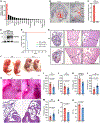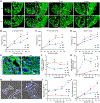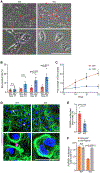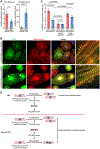RBPMS is an RNA-binding protein that mediates cardiomyocyte binucleation and cardiovascular development
- PMID: 35472321
- PMCID: PMC9116735
- DOI: 10.1016/j.devcel.2022.03.017
RBPMS is an RNA-binding protein that mediates cardiomyocyte binucleation and cardiovascular development
Abstract
Noncompaction cardiomyopathy is a common congenital cardiac disorder associated with abnormal ventricular cardiomyocyte trabeculation and impaired pump function. The genetic basis and underlying mechanisms of this disorder remain elusive. We show that the genetic deletion of RNA-binding protein with multiple splicing (Rbpms), an uncharacterized RNA-binding factor, causes perinatal lethality in mice due to congenital cardiovascular defects. The loss of Rbpms causes premature onset of cardiomyocyte binucleation and cell cycle arrest during development. Human iPSC-derived cardiomyocytes with RBPMS gene deletion have a similar blockade to cytokinesis. Sequencing analysis revealed that RBPMS plays a role in RNA splicing and influences RNAs involved in cytoskeletal signaling pathways. We found that RBPMS mediates the isoform switching of the heart-enriched LIM domain protein Pdlim5. The loss of Rbpms leads to an abnormal accumulation of Pdlim5-short isoforms, disrupting cardiomyocyte cytokinesis. Our findings connect premature cardiomyocyte binucleation to noncompaction cardiomyopathy and highlight the role of RBPMS in this process.
Keywords: Pdlim5; RNA-binding protein; Rbpms; alternative splicing; cardiomyocyte binucleation; hypertrabeculation; noncompaction cardiomyopathy; patent ductus arteriosus.
Copyright © 2022 Elsevier Inc. All rights reserved.
Conflict of interest statement
Declaration of interests E.N.O. is on the editorial board of Developmental Cell. The authors declare no other competing interests.
Figures






Comment in
-
RNA splicing to cytoskeleton: A new path to cardiomyocyte ploidy and division?Dev Cell. 2022 Apr 25;57(8):945-946. doi: 10.1016/j.devcel.2022.04.002. Dev Cell. 2022. PMID: 35472320
References
-
- ALI H, BRAGA L & GIACCA M 2020. Cardiac regeneration and remodelling of the cardiomyocyte cytoarchitecture. FEBS J, 287, 417–438. - PubMed
-
- ALMEIDA AG & PINTO FJ 2013. Non-compaction cardiomyopathy. Heart, 99, 1535–42. - PubMed
-
- ARNDT AK, SCHAFER S, DRENCKHAHN JD, SABEH MK, PLOVIE ER, CALIEBE A, KLOPOCKI E, MUSSO G, WERDICH AA, KALWA H, HEINIG M, PADERA RF, WASSILEW K, BLUHM J, HARNACK C, MARTITZ J, BARTON PJ, GREUTMANN M, BERGER F, HUBNER N, SIEBERT R, KRAMER HH, COOK SA, MACRAE CA & KLAASSEN S 2013. Fine mapping of the 1p36 deletion syndrome identifies mutation of PRDM16 as a cause of cardiomyopathy. Am J Hum Genet, 93, 67–77. - PMC - PubMed
Publication types
MeSH terms
Substances
Grants and funding
LinkOut - more resources
Full Text Sources
Molecular Biology Databases

